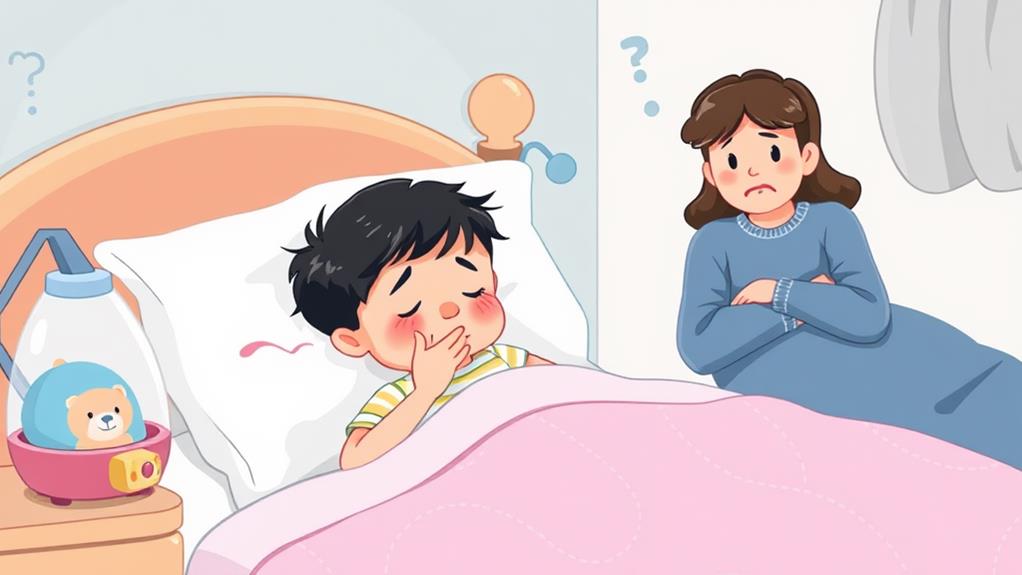Croup in Children: Symptoms, Risks, and Treatment Guide
When it comes to croup in children, understanding the symptoms and risks is essential for every parent. You might notice that distinctive barking cough or hear stridor, especially at night, and it can be concerning. While most cases are mild and manageable, knowing when to seek medical help can make all the difference. So, what are the best treatment options available, and how can you ensure your child recovers quickly? Exploring these questions will help you navigate this common childhood illness effectively.
Understanding Croup

Croup is a common respiratory condition that typically affects young children, especially those under five years old. It's often caused by viral infections, particularly those that lead to swelling in the airways. When your child contracts croup, you might notice changes in their breathing patterns, which can make it sound quite concerning.
Croup usually develops after your child has had a cold, so it's not entirely unexpected. You'll often see symptoms escalate at night, making it even more alarming for both you and your little one.
The good news is that most cases are mild and can be managed at home. Understanding croup is essential for parents like you, as it helps you feel more prepared when facing this situation.
The condition can cause a characteristic "barking" cough, which is a key sign to watch for. While it may sound dramatic, it's important to remember that most children recover quickly.
Knowing what croup is and how it develops can ease your worries. Being informed empowers you to take the right steps when your child needs help, ensuring they're comfortable and on the road to recovery.
Common Symptoms
After understanding the nature of croup, it's important to recognize the common symptoms that accompany this condition. One of the most notable symptoms is a distinctive barking cough, which can sound like a seal. This cough often gets worse at night, making it particularly alarming for both you and your child.
You might also notice that your child has difficulty breathing, which can manifest as stridor—a high-pitched wheezing sound when they inhale.
In addition to these symptoms, your child may experience a hoarse voice and a sore throat. Fever can also accompany croup, although it's typically mild.
As the condition progresses, you may observe your child feeling more restless or irritable, which can be challenging for both of you.
It's crucial to monitor these symptoms closely, as croup can vary in severity. While many cases are mild and manageable at home, some may require medical attention.
If your child's symptoms worsen, or if they exhibit signs of distress, such as rapid breathing or bluish skin, don't hesitate to seek help. Recognizing these signs early can make a significant difference in your child's comfort and care.
Causes of Croup

Understanding the causes of croup can help you better manage your child's condition. Croup is often triggered by viral infections, particularly those affecting the upper respiratory tract. The most common culprits are parainfluenza viruses, but other viruses like adenovirus and respiratory syncytial virus (RSV) can also play a role. These infections cause inflammation in your child's airways, leading to the characteristic barky cough and hoarseness associated with croup.
You might notice that croup typically affects young children, especially those aged six months to three years. This is because their airways are smaller and more susceptible to swelling. In some cases, croup can develop after your child has a cold, as the same viruses that cause colds can lead to croup symptoms.
It's important to monitor your child for any signs of croup, particularly during the fall and winter months when these viruses are more prevalent.
While most cases of croup are mild and manageable at home, knowing the causes can help you recognize when to seek medical attention to ensure your child's safety and comfort.
Risk Factors
Several factors can increase the likelihood of your child developing croup. For starters, age plays a significant role; children between six months and three years are at the highest risk. Their airways are smaller, making it easier for swelling to cause breathing difficulties.
Seasonal changes also contribute to croup's prevalence. You might notice that cases often spike in the fall and winter months when viral infections are more common.
If your child has a history of respiratory issues or allergies, they may be more susceptible to croup, as these conditions can make their airways more reactive to infections.
Additionally, exposure to secondhand smoke can heighten the risk. If someone smokes around your child, it could irritate their airways and increase the likelihood of croup.
Another factor is family history; if siblings or parents have had croup, your child may be more prone to it as well.
Diagnosis Process

Recognizing the signs of croup is the first step in the diagnosis process. When your child shows symptoms like a barking cough, stridor, or hoarseness, it's essential to take note of their severity and duration. You'll want to observe if your child's breathing seems labored or if they're struggling to catch their breath. These details can help you provide vital information to your healthcare provider.
Your doctor will likely begin with a physical examination, listening to your child's breathing with a stethoscope to check for any abnormal sounds. They'll also ask about symptoms and your child's medical history.
Sometimes, additional tests like a throat culture or a chest X-ray may be ordered, especially if there's a concern about other infections.
Keep in mind that croup is usually diagnosed based on symptoms, so your observations are crucial. If your child's symptoms are severe or worsening, don't hesitate to seek immediate care. Early diagnosis and proper assessment help ensure your child gets the right treatment, easing their discomfort and speeding up recovery.
Home Care Strategies
Managing croup at home can significantly ease your child's discomfort and aid in their recovery.
First, keep your child's environment calm and comfortable. Make sure their bedroom is well-ventilated but not too cold, as warm, moist air can help soothe their airways. You might want to run a cool-mist humidifier to keep the air moist, which can ease coughing and breathing difficulties.
Encourage your child to drink plenty of fluids, as staying hydrated is essential for recovery. Water, broth, and even popsicles can be great options.
If your child is feeling up to it, a warm bath can also help relax them and ease their symptoms.
When your child has a coughing fit, try to stay calm. Hold them close or sit in a comfortable position, as your presence can provide reassurance.
You could also step outside for a few minutes if the weather permits, as fresh air can sometimes alleviate the coughing.
When to Seek Medical Help

Knowing when to seek medical help for your child with croup is crucial for their safety and well-being. While many cases of croup can be managed at home, there are specific signs that indicate you should get professional assistance.
If your child has trouble breathing, appears to be struggling, or shows signs of wheezing, don't hesitate to call your doctor or go to the emergency room.
Also, keep an eye on their skin. If it begins to turn bluish, especially around the lips or face, this is a serious sign that your child needs immediate care. High fever that doesn't respond to typical medications or lasts for more than three days is another reason to seek help.
If your child's cough becomes bark-like and they seem unusually lethargic or irritable, it's time to reach out for medical advice.
Lastly, if you notice that your child's symptoms are worsening, even after you've applied home care strategies, don't wait. Trust your instincts—if you're feeling concerned, it's always better to err on the side of caution and seek help. Your child's health is worth it!
Medical Treatment Options
Effective medical treatment options for croup can significantly alleviate your child's symptoms and speed up recovery. When your child has croup, you might want to consult a healthcare provider to explore various treatment avenues.
One common approach is the use of corticosteroids, which help reduce inflammation in the airways. Dexamethasone is often prescribed and can make a noticeable difference in your child's breathing.
If your child's symptoms are severe, your doctor may recommend nebulized epinephrine. This treatment quickly opens the airways, providing relief from stridor and difficulty breathing. In some cases, your child might need to stay in the hospital for observation, especially if their symptoms worsen.
Additionally, keeping your child calm is essential, as anxiety can worsen breathing difficulties. Encouraging them to sip fluids can also help soothe their throat and keep them hydrated.
Always follow your healthcare provider's advice regarding medication dosages and treatment duration. Remember, while croup can be concerning, most children recover fully with proper care.
Preventive Measures

After addressing the medical treatment options for croup, it's important to consider how you can help prevent it from occurring in the first place. One of the best ways to reduce your child's risk of croup is to ensure they stay up to date with vaccinations. The flu vaccine, in particular, can help protect against illnesses that may lead to croup symptoms.
Encouraging good hygiene is another vital preventive measure. Teach your child to wash their hands regularly, especially before eating and after being in public places. Keeping your home clean and disinfecting surfaces can also help minimize the spread of viruses.
Additionally, try to avoid exposing your child to secondhand smoke, as it can irritate their airways and increase the chances of respiratory infections. When the weather gets colder, dress your child appropriately to avoid catching a cold.
Lastly, maintaining a smoke-free, well-ventilated environment can significantly benefit your child's respiratory health. By taking these steps, you can help protect your child and reduce the likelihood of croup.
Long-Term Outlook
Most children who experience croup recover without long-term complications. Typically, croup is a viral infection that causes swelling in the airways, leading to that characteristic barking cough.
Once your child has had croup, they're generally less likely to experience severe episodes again, especially if they're younger. Most kids outgrow it by age five or six.
While croup can be concerning, it usually resolves within a few days. After recovery, your child should return to their normal activities without any lingering effects.
However, it's essential to note that some children may experience recurrent croup, especially if they've underlying conditions like asthma or allergies.
In rare cases, croup can lead to complications, such as bacterial infections or difficulty breathing.
If you're ever worried about your child's symptoms, don't hesitate to consult your healthcare provider. They can offer guidance and reassurance, ensuring that your child receives appropriate care.













Post Comment